
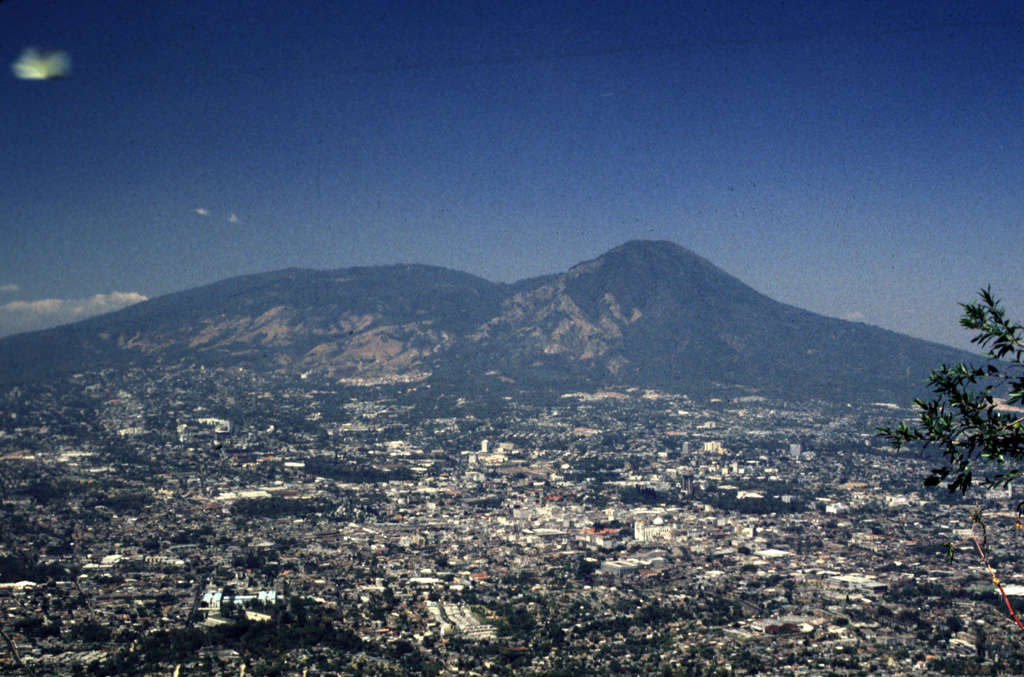
Minor volcano-tectonic seismicity detected
In August, several stations of the seismic network at San Salvador volcano recorded a few volcano-tectonic events 5 km from the crater. Local scientists investigated a fumarolic field, but nothing abnormal was found.
Information Contacts: Douglas Hernandez, Centro de Investigaciones Geotecnicas, Apartado Postal 109, San Salvador, El Salvador.
The Global Volcanism Program has no Weekly Reports available for San Salvador.
Reports are organized chronologically and indexed below by Month/Year (Publication Volume:Number), and include a one-line summary. Click on the index link or scroll down to read the reports.
Minor volcano-tectonic seismicity detected
In August, several stations of the seismic network at San Salvador volcano recorded a few volcano-tectonic events 5 km from the crater. Local scientists investigated a fumarolic field, but nothing abnormal was found.
Information Contacts: Douglas Hernandez, Centro de Investigaciones Geotecnicas, Apartado Postal 109, San Salvador, El Salvador.
|
|
||||||||||||||||||||||||||
There is data available for 5 confirmed eruptive periods.
1917 Jun 7 - 1917 Nov Confirmed Eruption (Explosive / Effusive) VEI: 3
| Episode 1 | Eruption (Explosive / Effusive) | Boquerón summit and north flank | ||||||||||||||||||||||||||||||||||||||||||||||||||||||||||
|---|---|---|---|---|---|---|---|---|---|---|---|---|---|---|---|---|---|---|---|---|---|---|---|---|---|---|---|---|---|---|---|---|---|---|---|---|---|---|---|---|---|---|---|---|---|---|---|---|---|---|---|---|---|---|---|---|---|---|---|
| 1917 Jun 7 - 1917 Nov | Evidence from Observations: Reported | ||||||||||||||||||||||||||||||||||||||||||||||||||||||||||
|
List of 10 Events for Episode 1 at Boquerón summit and north flank
|
|||||||||||||||||||||||||||||||||||||||||||||||||||||||||||
[ 1806 ] Uncertain Eruption
| Episode 1 | Eruption (Explosive / Effusive) | El Playón ? | ||||||||||||||||||
|---|---|---|---|---|---|---|---|---|---|---|---|---|---|---|---|---|---|---|---|
| 1806 - Unknown | Evidence from Unknown | ||||||||||||||||||
|
List of 2 Events for Episode 1 at El Playón ?
|
|||||||||||||||||||
1658 Nov 3 - 1671 Aug (on or after) Confirmed Eruption (Explosive / Effusive) VEI: 3
| Episode 1 | Eruption (Explosive / Effusive) | NW flank (El Playón), El Playón Sequence - Lower Playón | ||||||||||||||||||||||||||||||||||||||||||||||||
|---|---|---|---|---|---|---|---|---|---|---|---|---|---|---|---|---|---|---|---|---|---|---|---|---|---|---|---|---|---|---|---|---|---|---|---|---|---|---|---|---|---|---|---|---|---|---|---|---|---|
| 1658 Nov 3 - 1659 (?) | Evidence from Observations: Reported | ||||||||||||||||||||||||||||||||||||||||||||||||
|
List of 8 Events for Episode 1 at NW flank (El Playón), El Playón Sequence - Lower Playón
|
|||||||||||||||||||||||||||||||||||||||||||||||||
| Episode 2 | Eruption (Explosive / Effusive) | NW flank (El Playón), El Playón Sequence - Intermediate Playón | |||||||||||||
|---|---|---|---|---|---|---|---|---|---|---|---|---|---|---|
| 1660 - 1670 | Evidence from Correlation: Tephrochronology | |||||||||||||
|
List of 1 Events for Episode 2 at NW flank (El Playón), El Playón Sequence - Intermediate Playón
|
||||||||||||||
| Episode 3 | Eruption (Explosive / Effusive) | NW flank (El Playón), El Playón Sequence - Upper Playón | ||||||||||||||||||||||||||||
|---|---|---|---|---|---|---|---|---|---|---|---|---|---|---|---|---|---|---|---|---|---|---|---|---|---|---|---|---|---|
| 1671 Aug (?) - 1671 Aug (on or after) | Evidence from Observations: Reported | ||||||||||||||||||||||||||||
|
List of 4 Events for Episode 3 at NW flank (El Playón), El Playón Sequence - Upper Playón
|
|||||||||||||||||||||||||||||
1575 Confirmed Eruption (Explosive / Effusive) VEI: 3 (?)
| Episode 1 | Eruption (Explosive / Effusive) | Loma de Grandes Bloques | |||||||||||||||||||||||
|---|---|---|---|---|---|---|---|---|---|---|---|---|---|---|---|---|---|---|---|---|---|---|---|---|
| 1575 - Unknown | Evidence from Observations: Reported | |||||||||||||||||||||||
|
List of 3 Events for Episode 1 at Loma de Grandes Bloques
|
||||||||||||||||||||||||
1200 (?) Confirmed Eruption (Explosive / Effusive) VEI: 4
| Episode 1 | Eruption (Explosive / Effusive) | Boquerón, San Andrés Talpetate Tuff | |||||||||||||||||||||||||||||||||||||||||||||||||||||
|---|---|---|---|---|---|---|---|---|---|---|---|---|---|---|---|---|---|---|---|---|---|---|---|---|---|---|---|---|---|---|---|---|---|---|---|---|---|---|---|---|---|---|---|---|---|---|---|---|---|---|---|---|---|---|
| 1200 (?) - Unknown | Evidence from Correlation: Anthropology | |||||||||||||||||||||||||||||||||||||||||||||||||||||
|
List of 9 Events for Episode 1 at Boquerón, San Andrés Talpetate Tuff
|
||||||||||||||||||||||||||||||||||||||||||||||||||||||
0640 Aug ± 30 years Confirmed Eruption (Explosive / Effusive) VEI: 3 (?)
| Episode 1 | Eruption (Explosive / Effusive) | NW flank (Loma Caldera) | ||||||||||||||||||||||||||||||||||||||||||||||||||||||||||||||||||||
|---|---|---|---|---|---|---|---|---|---|---|---|---|---|---|---|---|---|---|---|---|---|---|---|---|---|---|---|---|---|---|---|---|---|---|---|---|---|---|---|---|---|---|---|---|---|---|---|---|---|---|---|---|---|---|---|---|---|---|---|---|---|---|---|---|---|---|---|---|---|
| 0640 Aug ± 30 years - Unknown | Evidence from Isotopic: 14C (calibrated) | ||||||||||||||||||||||||||||||||||||||||||||||||||||||||||||||||||||
|
List of 12 Events for Episode 1 at NW flank (Loma Caldera)
|
|||||||||||||||||||||||||||||||||||||||||||||||||||||||||||||||||||||
[ 1040 BCE ± 300 years ] Discredited Eruption
This compilation of synonyms and subsidiary features may not be comprehensive. Features are organized into four major categories: Cones, Craters, Domes, and Thermal Features. Synonyms of features appear indented below the primary name. In some cases additional feature type, elevation, or location details are provided.
Cones |
||||
| Feature Name | Feature Type | Elevation | Latitude | Longitude |
| 14 de Marzo, Cerro | Pyroclastic cone | |||
| Aurora, Crater La | Tuff cone | |||
| Boquerón, El
Quezaltepeque |
Stratovolcano | 1893 m | 13° 44' 3.00" N | 89° 17' 38.00" W |
| Boqueroncito | Pyroclastic cone | 1335 m | 13° 44' 12.00" N | 89° 17' 10.00" W |
| Cerrito, Cerro el
Balastrera, El Cerrito Realenco, El |
Pyroclastic cone | 606 m | 13° 48' 58.00" N | 89° 15' 50.00" W |
| Ciega, Laguna | Pyroclastic cone | 480 m | 13° 50' 0.00" N | 89° 21' 0.00" W |
| Grandes Bloques, Loma de | Pyroclastic cone | |||
| Hoya, Cerro la | Pyroclastic cone | |||
| Hoya, Plan de la | Tuff cone | |||
| Hoyo, Plan del | Pyroclastic cone | |||
| Jabalí, Cerro El
Amatepeque |
Stratovolcano | 1400 m | 13° 45' 4.00" N | 89° 19' 1.00" W |
| Joya, La | Pyroclastic cone | 13° 42' 0.00" N | 89° 16' 0.00" W | |
| Laguna Caldera | Pyroclastic cone | 505 m | 13° 50' 26.00" N | 89° 21' 24.00" W |
| Loma Caldera | Tuff ring | 510 m | 13° 51' 0.00" N | 89° 22' 0.00" W |
| Picacho, El | Stratovolcano | 1960 m | 13° 44' 35.00" N | 89° 25' 23.00" W |
| Playón, El | Pyroclastic cone | 665 m | 13° 48' 43.00" N | 89° 19' 55.00" W |
| Resumidero | Tuff ring | |||
| Unnamed 1A | Pyroclastic cone | |||
| Unnamed 1B | Pyroclastic cone | |||
| Unnamed 2 | Pyroclastic cone | |||
| Viboras, Montaña las | Pyroclastic cone | 519 m | 13° 50' 30.00" N | 89° 20' 30.00" W |
Craters |
||||
| Feature Name | Feature Type | Elevation | Latitude | Longitude |
| Boca Tronadora | Fissure vent | 480 m | 13° 50' 0.00" N | 89° 21' 0.00" W |
| Bogueroncitos | Fissure vent | 13° 45' 0.00" N | 89° 18' 0.00" W | |
| Chanmico, Laguna de | Maar | 466 m | 13° 47' 0.00" N | 89° 21' 0.00" W |
| Chinitos, Los | Fissure vent | 500 m | 13° 49' 0.00" N | 89° 20' 0.00" W |
| Crater Lavas El Playón | Crater | |||
| Escondida, Crater la | Crater | |||
| Granadillas, Las | Maar | |||
| Jabali, Boca del | Crater | |||
| Jabalion | Crater | |||
| Puerta de la Laguna
Plan de la Laguna |
Maar | 800 m | 13° 40' 0.00" N | 89° 15' 0.00" W |
| Sitio Grande
Jabalincito, El |
Crater | 820 m | 13° 46' 0.00" N | 89° 20' 0.00" W |
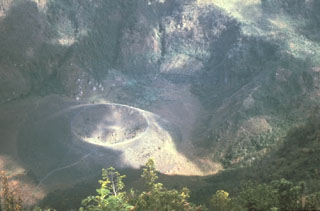 This scoria cone on the floor of the Boquerón summit crater at San Salvador was built during an eruption that began on 6 June 1917 on the upper north flank of Boquerón. A chain of scoria cones formed, and a lava flow traveled to the northwest, cutting the railroad between Quezaltepeque and Sitio del Niño. The Boquerón summit crater lake began to boil by 10 June and disappeared by 28 June, after which this small cone (Boqueroncito) formed on the crater floor.
This scoria cone on the floor of the Boquerón summit crater at San Salvador was built during an eruption that began on 6 June 1917 on the upper north flank of Boquerón. A chain of scoria cones formed, and a lava flow traveled to the northwest, cutting the railroad between Quezaltepeque and Sitio del Niño. The Boquerón summit crater lake began to boil by 10 June and disappeared by 28 June, after which this small cone (Boqueroncito) formed on the crater floor.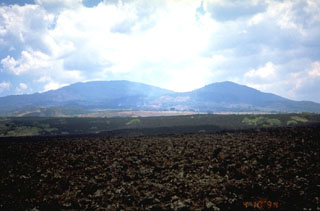 The barren lava flow in the foreground was formed during a 1917 eruption from vents on the flank of Boquerón stratovolcano, the rounded peak at the left. The lava flow cut the railway SW of Quezaltepeque. The 1917 eruption also produced a small cinder cone in the summit crater of Boquerón. Boquerón has grown within a 6-km-wide caldera whose western rim forms El Jabalí peak (right). Three fracture zones that extend beyond the base of the volcano have been the locus for numerous flank eruptions of Santa Ana volcano.
The barren lava flow in the foreground was formed during a 1917 eruption from vents on the flank of Boquerón stratovolcano, the rounded peak at the left. The lava flow cut the railway SW of Quezaltepeque. The 1917 eruption also produced a small cinder cone in the summit crater of Boquerón. Boquerón has grown within a 6-km-wide caldera whose western rim forms El Jabalí peak (right). Three fracture zones that extend beyond the base of the volcano have been the locus for numerous flank eruptions of Santa Ana volcano. 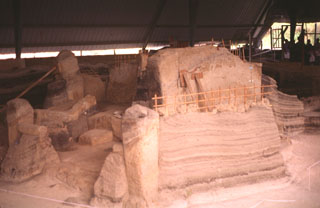 Laminated pyroclastic surge deposits surround the walls of houses buried by an eruption from the Laguna Caldera scoria cone on the lower NW flank of San Salvador. This eruption occurred around 590 CE and buried at least three Mayan homesteads beneath more than 4 m of scoria and ash.
Laminated pyroclastic surge deposits surround the walls of houses buried by an eruption from the Laguna Caldera scoria cone on the lower NW flank of San Salvador. This eruption occurred around 590 CE and buried at least three Mayan homesteads beneath more than 4 m of scoria and ash.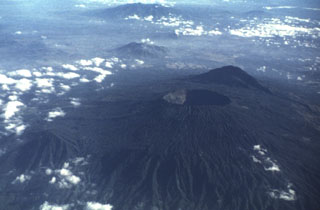 Boquerón volcano, its summit cut by a steep-walled, 500-m-deep crater, was constructed within a 6-km-wide caldera whose largely obscured rims are visible in this aerial photo from the WSW. The caldera cut an older San Salvador edifice, remnants of which are visible at El Picacho peak (in the shadow behind Boquerón) and El Jabalí (the low peak at the lower left). The buried caldera rim in the foreground is defined by the change in degree of dissection of the volcano's flanks. Guazapa volcano can be seen in the distance at the top of the photo.
Boquerón volcano, its summit cut by a steep-walled, 500-m-deep crater, was constructed within a 6-km-wide caldera whose largely obscured rims are visible in this aerial photo from the WSW. The caldera cut an older San Salvador edifice, remnants of which are visible at El Picacho peak (in the shadow behind Boquerón) and El Jabalí (the low peak at the lower left). The buried caldera rim in the foreground is defined by the change in degree of dissection of the volcano's flanks. Guazapa volcano can be seen in the distance at the top of the photo.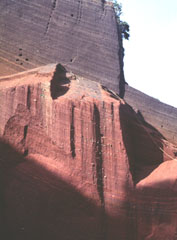 Oxidized red scoria deposits are exposed in a quarry on Cerro el Cerrito, a scoria cone on the lower northern flank of San Salvador immediately SE of the town of Quezaltepeque.
Oxidized red scoria deposits are exposed in a quarry on Cerro el Cerrito, a scoria cone on the lower northern flank of San Salvador immediately SE of the town of Quezaltepeque.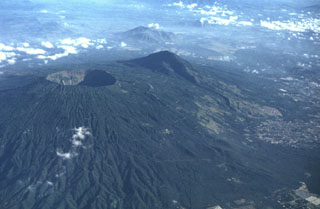 The 1.5-km-wide Boquerón crater formed during a major eruption about 1200 CE. The eruption produced a 0.3-0.5 km3 San Andrés Talpetate Tuff that went primarily to the west, and was accompanied by pyroclastic flows. The eruption was named after the San Andrés archaeological site, where it was first identified. The outskirts of the city of San Salvador extend up the flank to the right.
The 1.5-km-wide Boquerón crater formed during a major eruption about 1200 CE. The eruption produced a 0.3-0.5 km3 San Andrés Talpetate Tuff that went primarily to the west, and was accompanied by pyroclastic flows. The eruption was named after the San Andrés archaeological site, where it was first identified. The outskirts of the city of San Salvador extend up the flank to the right. San Salvador volcano rises above the capital city of El Salvador. The broader peak to the left is the Boquerón edifice, which has grown within the 6-km-wide crater of the older El Picacho edifice (the peak to the right). Most of the four pre-1917 eruptions recorded at San Salvador since the 16th century have occurred at flank vents.
San Salvador volcano rises above the capital city of El Salvador. The broader peak to the left is the Boquerón edifice, which has grown within the 6-km-wide crater of the older El Picacho edifice (the peak to the right). Most of the four pre-1917 eruptions recorded at San Salvador since the 16th century have occurred at flank vents.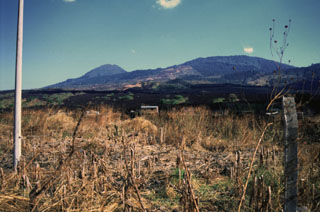 The dark-colored lava flow in the center of the photo originated during an eruption in 1917 from a vent high on the northern flank of Boquerón volcano (upper right). On June 6, 1917 an eruption began from NW-trending fissures on the upper north flank of Boquerón. A chain of cinder cones formed and a lava flow traveled to the northwest, cutting the railroad between Quezaltepeque and Sitio del Niño. Eruptive activity also occurred at the summit crater of Boquerón, where a small conelet formed on the crater floor. El Picacho peak is at the left.
The dark-colored lava flow in the center of the photo originated during an eruption in 1917 from a vent high on the northern flank of Boquerón volcano (upper right). On June 6, 1917 an eruption began from NW-trending fissures on the upper north flank of Boquerón. A chain of cinder cones formed and a lava flow traveled to the northwest, cutting the railroad between Quezaltepeque and Sitio del Niño. Eruptive activity also occurred at the summit crater of Boquerón, where a small conelet formed on the crater floor. El Picacho peak is at the left.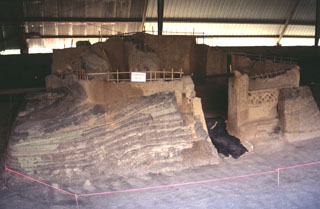 An excavation at the Joya de Cerén archaeological site in the Zapotitán Valley shows pyroclastic surge deposits from the 590 CE eruption of the Laguna Caldera scoria cone against Mayan buildings. The excavation has unearthed several small Protoclassic Mayan homesteads that were buried by this eruption on the northern flank of San Salvador. They contain the remains of uneaten meals left by occupants who evacuated their houses.
An excavation at the Joya de Cerén archaeological site in the Zapotitán Valley shows pyroclastic surge deposits from the 590 CE eruption of the Laguna Caldera scoria cone against Mayan buildings. The excavation has unearthed several small Protoclassic Mayan homesteads that were buried by this eruption on the northern flank of San Salvador. They contain the remains of uneaten meals left by occupants who evacuated their houses.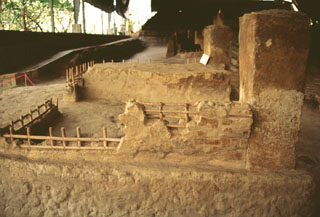 An archeological excavation near the community of Cerén has unearthed several small Protoclassic Mayan homesteads that were buried by an eruption from the nearby Laguna Caldera scoria cone on the northern flank of San Salvador. The eruption occurred suddenly, as seen from the remains of uneaten meals left by occupants who fled their houses. The eruption was radiocarbon dated at about 590 CE.
An archeological excavation near the community of Cerén has unearthed several small Protoclassic Mayan homesteads that were buried by an eruption from the nearby Laguna Caldera scoria cone on the northern flank of San Salvador. The eruption occurred suddenly, as seen from the remains of uneaten meals left by occupants who fled their houses. The eruption was radiocarbon dated at about 590 CE.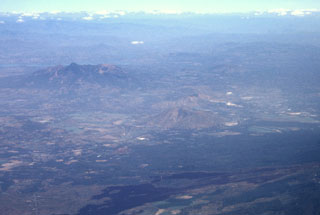 The massive Pleistocene Guazapa stratovolcano (left-center) is seen here in an aerial view from the SW with the Río Lempa behind it. The youngest flank vent of Guazapa is Cerro Macanze, which lies on the SE flank of the volcano, behind the two small volcanoes in the right-center part of the photo. The dark-colored unvegetated lava flow in the foreground was erupted in 1917 from the flank of San Salvador volcano.
The massive Pleistocene Guazapa stratovolcano (left-center) is seen here in an aerial view from the SW with the Río Lempa behind it. The youngest flank vent of Guazapa is Cerro Macanze, which lies on the SE flank of the volcano, behind the two small volcanoes in the right-center part of the photo. The dark-colored unvegetated lava flow in the foreground was erupted in 1917 from the flank of San Salvador volcano.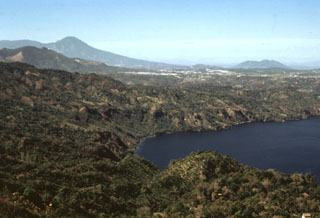 The SW corner of Ilopango caldera is visible in the foreground with the outskirts of the capital city of San Salvador behind it. The high peak on the left horizon (NW) is El Picacho, part of the San Salvador volcanic complex, a recently active volcano overlooking the capital city. Below it to the left is San Jacinto, a Pliocene lava dome complex. The broad peak in the background to the right is the Pliocene Cerro Nejapa volcano.
The SW corner of Ilopango caldera is visible in the foreground with the outskirts of the capital city of San Salvador behind it. The high peak on the left horizon (NW) is El Picacho, part of the San Salvador volcanic complex, a recently active volcano overlooking the capital city. Below it to the left is San Jacinto, a Pliocene lava dome complex. The broad peak in the background to the right is the Pliocene Cerro Nejapa volcano.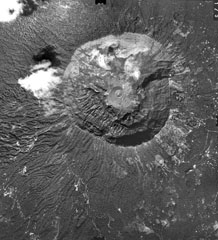 The summit of San Salvador volcano is truncated by a large steep-walled crater, Boquerón (the mouth), which formed during a major eruption producing the San Andrés Talpetate Tuff about 800 years ago. Eruption of west-directed airfall tephra was accompanied by pyroclastic flows. The small 30-m-high cinder cone, Boqueroncito (the little mouth) is seen in the center of the crater floor of 1.5-km-wide, 500-m-deep Boquerón and was constructed during the 1917 eruption.
The summit of San Salvador volcano is truncated by a large steep-walled crater, Boquerón (the mouth), which formed during a major eruption producing the San Andrés Talpetate Tuff about 800 years ago. Eruption of west-directed airfall tephra was accompanied by pyroclastic flows. The small 30-m-high cinder cone, Boqueroncito (the little mouth) is seen in the center of the crater floor of 1.5-km-wide, 500-m-deep Boquerón and was constructed during the 1917 eruption.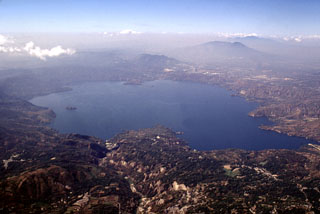 The 8 x 11 km wide Ilopango caldera fills the center of the image in this view from the ESE. Fresh, light-colored exposures of the Tierra Blanca Joven formation in the foreground associated with the latest caldera-forming episode were in part created by landslides during the January 2001 earthquake. The capital city of San Salvador lies beyond the lake, in front of San Salvador volcano (upper right). The Santa Ana volcanic complex lies beyond San Salvador volcano in the background to the far right.
The 8 x 11 km wide Ilopango caldera fills the center of the image in this view from the ESE. Fresh, light-colored exposures of the Tierra Blanca Joven formation in the foreground associated with the latest caldera-forming episode were in part created by landslides during the January 2001 earthquake. The capital city of San Salvador lies beyond the lake, in front of San Salvador volcano (upper right). The Santa Ana volcanic complex lies beyond San Salvador volcano in the background to the far right.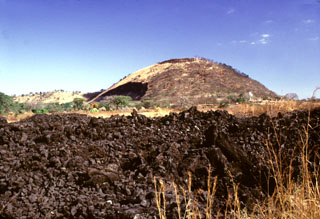 El Playón scoria cone on the lower NW flank of Santa Ana formed during an eruption in 1658. The eruption began on 3 November 1658, producing ashfall in Comayagua and a lava flow (left) to the NE that surrounded the village of Nejapa. The lava flow in the foreground was emplaced in 1917 from a vent on the upper northern flank of San Salvador.
El Playón scoria cone on the lower NW flank of Santa Ana formed during an eruption in 1658. The eruption began on 3 November 1658, producing ashfall in Comayagua and a lava flow (left) to the NE that surrounded the village of Nejapa. The lava flow in the foreground was emplaced in 1917 from a vent on the upper northern flank of San Salvador.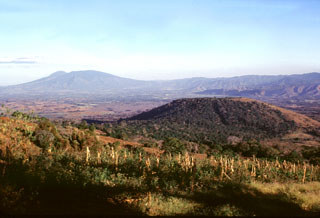 Cerro Alto (right) is a scoria cone on the SE flank of Coatepeque caldera, seen here from the southern caldera rim. Basaltic lava flows were erupted from the eastern side of the cone. Cerro Alto predates the formation of Coatepeque caldera and is overlain by deposits from the caldera-forming eruptions. San Salvador volcano is on the horizon to the east (left).
Cerro Alto (right) is a scoria cone on the SE flank of Coatepeque caldera, seen here from the southern caldera rim. Basaltic lava flows were erupted from the eastern side of the cone. Cerro Alto predates the formation of Coatepeque caldera and is overlain by deposits from the caldera-forming eruptions. San Salvador volcano is on the horizon to the east (left).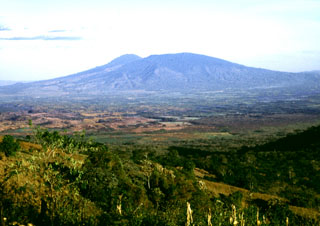 This view from the southern rim of Coatepeque shows the western side of San Salvador volcano. The broad Boquerón edifice has grown within a large crater within an older stratovolcano, of which rounded Picacho to the left is a remnant. The flat brown-colored area to the right is the 1722 lava flow from San Marcelino scoria cone on the lower flank of Santa Ana.
This view from the southern rim of Coatepeque shows the western side of San Salvador volcano. The broad Boquerón edifice has grown within a large crater within an older stratovolcano, of which rounded Picacho to the left is a remnant. The flat brown-colored area to the right is the 1722 lava flow from San Marcelino scoria cone on the lower flank of Santa Ana.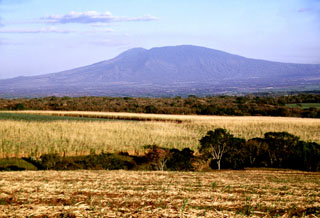 The western flanks of San Salvador rise above the Zapotitán basin beyond sugar cane fields south of Coatepeque caldera. These flanks and the rounded El Picacho peak left of the summit are part of the ancestral San Salvador volcano. The broad Boquerón edifice subsequently grew over much of the caldera rim, and lava flows traveled down the northern and southern flanks, smoothing its profile.
The western flanks of San Salvador rise above the Zapotitán basin beyond sugar cane fields south of Coatepeque caldera. These flanks and the rounded El Picacho peak left of the summit are part of the ancestral San Salvador volcano. The broad Boquerón edifice subsequently grew over much of the caldera rim, and lava flows traveled down the northern and southern flanks, smoothing its profile. 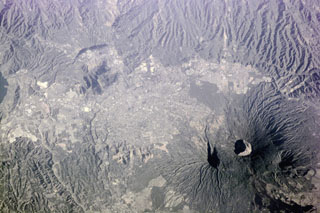 The capital city of San Salvador extends across much of this photo taken from the International Space Station (with north to the bottom) and encroaches on the flanks of San Salvador volcano. The Boquerón crater is 1.5 km wide and lies within a late-Pleistocene crater whose eastern wall is shown by the shadow to the left. The dark area to the bottom right is a flank lava flow produced during the 1917 eruption.
The capital city of San Salvador extends across much of this photo taken from the International Space Station (with north to the bottom) and encroaches on the flanks of San Salvador volcano. The Boquerón crater is 1.5 km wide and lies within a late-Pleistocene crater whose eastern wall is shown by the shadow to the left. The dark area to the bottom right is a flank lava flow produced during the 1917 eruption.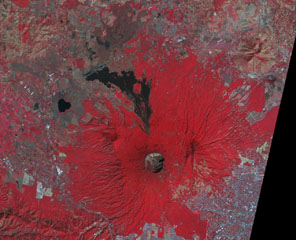 This false-color NASA ASTER image (N is at the top) looks down on the 1.5-km-wide San Salvador summit crater. The lava flow to the north was erupted from a flank vent in 1917; the small cone in the center of the summit crater also formed that year. Lake-filled Laguna de Chanmico maar lies on the lower NW flank (left-center). The capital city of San Salvador is at the lower right.
This false-color NASA ASTER image (N is at the top) looks down on the 1.5-km-wide San Salvador summit crater. The lava flow to the north was erupted from a flank vent in 1917; the small cone in the center of the summit crater also formed that year. Lake-filled Laguna de Chanmico maar lies on the lower NW flank (left-center). The capital city of San Salvador is at the lower right.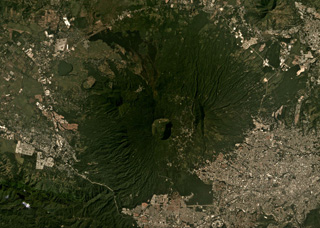 The 1.5-km-wide Boquerón crater of San Salvador is in the center of this November 2019 Planet Labs satellite image monthly mosaic (N is at the top), with the small Boqueroncito scoria cone in the center. A 6 x 4.5 km caldera formed around 40-30 ka and the current El Boquerón edifice was built within it. Recent activity was concentrated in the northern sector with lava flows emplaced on the N flank and within the crater.
The 1.5-km-wide Boquerón crater of San Salvador is in the center of this November 2019 Planet Labs satellite image monthly mosaic (N is at the top), with the small Boqueroncito scoria cone in the center. A 6 x 4.5 km caldera formed around 40-30 ka and the current El Boquerón edifice was built within it. Recent activity was concentrated in the northern sector with lava flows emplaced on the N flank and within the crater.The following 4 samples associated with this volcano can be found in the Smithsonian's NMNH Department of Mineral Sciences collections, and may be availble for research (contact the Rock and Ore Collections Manager). Catalog number links will open a window with more information.
| Catalog Number | Sample Description | Lava Source | Collection Date |
|---|---|---|---|
| NMNH 91045-1 | Lava | -- | -- |
| NMNH 91045-2 | Lava | -- | -- |
| NMNH 91406-1 | Basalt | -- | -- |
| NMNH 91406-2 | Basalt | -- | -- |
| Copernicus Browser | The Copernicus Browser replaced the Sentinel Hub Playground browser in 2023, to provide access to Earth observation archives from the Copernicus Data Space Ecosystem, the main distribution platform for data from the EU Copernicus missions. |
| MIROVA | Middle InfraRed Observation of Volcanic Activity (MIROVA) is a near real time volcanic hot-spot detection system based on the analysis of MODIS (Moderate Resolution Imaging Spectroradiometer) data. In particular, MIROVA uses the Middle InfraRed Radiation (MIR), measured over target volcanoes, in order to detect, locate and measure the heat radiation sourced from volcanic activity. |
| MODVOLC Thermal Alerts | Using infrared satellite Moderate Resolution Imaging Spectroradiometer (MODIS) data, scientists at the Hawai'i Institute of Geophysics and Planetology, University of Hawai'i, developed an automated system called MODVOLC to map thermal hot-spots in near real time. For each MODIS image, the algorithm automatically scans each 1 km pixel within it to check for high-temperature hot-spots. When one is found the date, time, location, and intensity are recorded. MODIS looks at every square km of the Earth every 48 hours, once during the day and once during the night, and the presence of two MODIS sensors in space allows at least four hot-spot observations every two days. Each day updated global maps are compiled to display the locations of all hot spots detected in the previous 24 hours. There is a drop-down list with volcano names which allow users to 'zoom-in' and examine the distribution of hot-spots at a variety of spatial scales. |
|
WOVOdat
Single Volcano View Temporal Evolution of Unrest Side by Side Volcanoes |
WOVOdat is a database of volcanic unrest; instrumentally and visually recorded changes in seismicity, ground deformation, gas emission, and other parameters from their normal baselines. It is sponsored by the World Organization of Volcano Observatories (WOVO) and presently hosted at the Earth Observatory of Singapore.
GVMID Data on Volcano Monitoring Infrastructure The Global Volcano Monitoring Infrastructure Database GVMID, is aimed at documenting and improving capabilities of volcano monitoring from the ground and space. GVMID should provide a snapshot and baseline view of the techniques and instrumentation that are in place at various volcanoes, which can be use by volcano observatories as reference to setup new monitoring system or improving networks at a specific volcano. These data will allow identification of what monitoring gaps exist, which can be then targeted by remote sensing infrastructure and future instrument deployments. |
| Volcanic Hazard Maps | The IAVCEI Commission on Volcanic Hazards and Risk has a Volcanic Hazard Maps database designed to serve as a resource for hazard mappers (or other interested parties) to explore how common issues in hazard map development have been addressed at different volcanoes, in different countries, for different hazards, and for different intended audiences. In addition to the comprehensive, searchable Volcanic Hazard Maps Database, this website contains information about diversity of volcanic hazard maps, illustrated using examples from the database. This site is for educational purposes related to volcanic hazard maps. Hazard maps found on this website should not be used for emergency purposes. For the most recent, official hazard map for a particular volcano, please seek out the proper institutional authorities on the matter. |
| IRIS seismic stations/networks | Incorporated Research Institutions for Seismology (IRIS) Data Services map showing the location of seismic stations from all available networks (permanent or temporary) within a radius of 0.18° (about 20 km at mid-latitudes) from the given location of San Salvador. Users can customize a variety of filters and options in the left panel. Note that if there are no stations are known the map will default to show the entire world with a "No data matched request" error notice. |
| UNAVCO GPS/GNSS stations | Geodetic Data Services map from UNAVCO showing the location of GPS/GNSS stations from all available networks (permanent or temporary) within a radius of 20 km from the given location of San Salvador. Users can customize the data search based on station or network names, location, and time window. Requires Adobe Flash Player. |
| DECADE Data | The DECADE portal, still in the developmental stage, serves as an example of the proposed interoperability between The Smithsonian Institution's Global Volcanism Program, the Mapping Gas Emissions (MaGa) Database, and the EarthChem Geochemical Portal. The Deep Earth Carbon Degassing (DECADE) initiative seeks to use new and established technologies to determine accurate global fluxes of volcanic CO2 to the atmosphere, but installing CO2 monitoring networks on 20 of the world's 150 most actively degassing volcanoes. The group uses related laboratory-based studies (direct gas sampling and analysis, melt inclusions) to provide new data for direct degassing of deep earth carbon to the atmosphere. |
| Large Eruptions of San Salvador | Information about large Quaternary eruptions (VEI >= 4) is cataloged in the Large Magnitude Explosive Volcanic Eruptions (LaMEVE) database of the Volcano Global Risk Identification and Analysis Project (VOGRIPA). |
| EarthChem | EarthChem develops and maintains databases, software, and services that support the preservation, discovery, access and analysis of geochemical data, and facilitate their integration with the broad array of other available earth science parameters. EarthChem is operated by a joint team of disciplinary scientists, data scientists, data managers and information technology developers who are part of the NSF-funded data facility Integrated Earth Data Applications (IEDA). IEDA is a collaborative effort of EarthChem and the Marine Geoscience Data System (MGDS). |